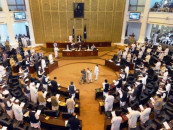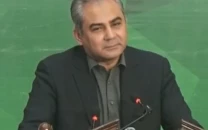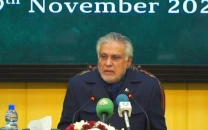Govt eliminates customs duties on 4,000 tariff lines in trade reform
FinMin highlighted that reductions in tariff duties would specifically benefit Pakistan’s industrial, export sectors

Finance Minister Muhammad Aurangzeb confirmed that the federal government had eliminated additional customs duties on 4,000 out of 7,000 tariff lines, while reducing duties on a further 2,700.
In a post-budget press briefing on Wednesday, FinMin Aurangzeb outlined a comprehensive tariff reform plan, aimed at driving industrial growth and boosting exports in a bid to transition the country towards a more globally integrated economy.
He called the tariff rationalisation a “major and important step” in aligning Pakistan’s trade and industrial policy with international standards.
“This is a structural reform that hasn’t been undertaken in the past 30 years,” said Aurangzeb. “From a reform perspective, this is a huge step, and we’re committed to taking it forward gradually.”
سرکاری ملازمین کی تنخواہوں اور پینشن میں اضافہ افراط کو مد نظر رکھ کر کیا گیا ہے
— PTV News (@PTVNewsOfficial) June 11, 2025
وفاقی وزیر خزانہ
پوسٹ بجٹ بریفنگ @Financegovpk#Budget2025 #Ptvnewshttps://t.co/RkkICHz1gK pic.twitter.com/haHqQOtom9
The tariff reform, part of Pakistan’s broader economic restructuring plan, includes significant reductions in duties on raw materials and intermediary goods used by exporters.
Aurangzeb said that the move was designed to reduce input costs, thereby improving Pakistan’s competitiveness in international markets.
Focus on Industrial Growth and Exports
Pakistan’s trade and industrial sectors have long been weighed down by high tariffs and protectionist policies. The finance minister stated that this shift away from import substitution was essential to address Pakistan’s recurring balance of payments crises and the pressures of dollar liquidity.
Read More: Finance minister unveils Rs17.6tn budget, targets 4.2% growth
“If we want to structurally reposition the country toward export-led growth, we need to change the very DNA of the economy,” Aurangzeb explained. “That’s how we avoid falling into the same cycle of dollar shortages every time we try to grow.”
The minister also highlighted that the reductions in tariff duties would specifically benefit Pakistan’s industrial and export sectors, noting that approximately 2,000 tariff lines were linked to key raw materials and intermediary goods.
The government’s broader goal is to streamline the tariff structure to support industrial growth and integrate the economy more deeply into global supply chains.
Fiscal Measures and Support for Key Sectors
Aurangzeb also outlined the government's fiscal measures designed to balance economic growth with equity, focusing on relief for salaried individuals and mid-sized businesses. He stated that the government had tried to offer as much relief as possible within the constraints of available fiscal space.
“The government has carefully considered different slabs, including at the highest levels, to provide as much relief as fiscal space allows,” he said.
In terms of support for key sectors, Aurangzeb mentioned that the government is prioritising construction and agriculture. Reforms in these sectors are aimed at lowering transaction costs, supporting affordable housing, and ensuring greater access to credit for small farmers.
The finance minister also revealed plans to launch a new housing finance scheme in collaboration with the State Bank of Pakistan, aimed at making mortgage financing more accessible for citizens.
Taxation and Digital Economy Reforms
Aurangzeb also addressed the government’s push to formalise Pakistan’s vast informal economy. He stated that the government was making strides towards digitalising the economy, introducing a new e-commerce framework to regulate local digital markets. As part of this effort, small businesses operating on online platforms will be required to register for a National Tax Number (NTN) and pay a minimal tax.
Additionally, the government has imposed an 18% General Sales Tax (GST) on solar power plant imports to incentivise local solar panel manufacturing, further emphasising Pakistan’s commitment to sustainability.
Revenue Growth and Fiscal Management
On the fiscal front, Aurangzeb reported that the government had managed to generate over Rs400 billion in additional revenue this fiscal year through improved enforcement of tax laws. The tax-to-GDP ratio is projected to rise to 10.4% this year, with an aim of reaching 10.9% by FY2025-26.
The government’s broader reform agenda includes a legislative push to strengthen tax enforcement and enhance compliance across the economy.
External Financing and International Markets
Looking ahead, Aurangzeb outlined plans to expand Pakistan’s access to international financial markets. He announced that the government was preparing to make the first installment payment of $500 million on Euro bonds due in September, and revealed plans for Pakistan’s inaugural Panda Bond issuance later this year.
The minister emphasised the importance of improving Pakistan's credit ratings to access the Euro and US dollar bond markets by 2026.
With structural reforms and fiscal measures in place, the government aims to stabilise the economy, attract investment, and lay the groundwork for a more resilient and export-driven future.
Also Read: Salaried class gets tax relief
Earlier, the finance minister arrived for the briefing accompanied by the Finance Secretary and the Chairman of the Federal Board of Revenue (FBR). However, journalists boycotted the press conference in protest over the absence of a technical briefing on the budget.
Reporters noted that for the past 20 years, it has been standard practice to provide a technical briefing to journalists following the budget. This year, they said, the government broke that tradition.
Later, the finance minister instructed relevant officials to persuade the journalists to return.













1729471601-0/image-(8)1729471601-0-208x130.webp)







COMMENTS
Comments are moderated and generally will be posted if they are on-topic and not abusive.
For more information, please see our Comments FAQ